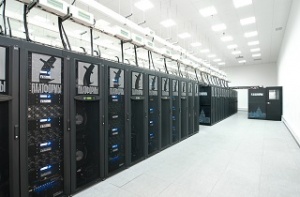Lomonosov Supercomputer
Home * Hardware * Lomonosov Supercomputer

Lomonosov Supercomputer,
a Russian supercomputer, designed by T-Platforms and installed at the Lomonosov Moscow State University in 2009. The system launch ceremony was attended by Dmitry A. Medvedev, then President of the Russian Federation, who proposed to name the supercomputer after the great Russian 18th century scientist and founder of the MSU, Mikhail Lomonosov.
Initially, the computer consisted of a main section of 4160 4-core Intel x86-64 Xeon 5570 processors, and a second section including 260 X5570 and local hard drives, Blade2 server nodes interconnected by InfiniBand quad data rate serial links. In 2011, the Lomonosov computer was supplemented with 777 nodes equipped with GPU-based NVIDIA Tesla X2070 accelerators, and in 2012 further expanded with 288 nodes of Xeon X5570/X5670 processors and GPU accelerators.
Performance
As of 2012, the Lomonosov Supercomputer has 52,168 x86-64 and 954,840 GPU cores [2] with 92 TiB of triple-channel DDR3 SD memory modules, resulting in a peak performance of 1.7 PFlops, and a Linpack performance of 901.9 TFlops. Operating system is the Linux based ClustrX [3] . The Lomonosov supercomputer includes a three-tier storage with high-speed disks of 500 TB running under the Lustre parallel file system, a high-speed, highly-reliable 300TB disk storage, and a 1PB robotic tape storage.
Lomonosov Tablebases
One scientific as well as commercial research application using the Lomonosov Supercomputer was the generation of the 7-men Lomonosov Tablebases [4] headed by Victor Zakharov and Vladimir Makhnychev [5] . As of December 31, 2013, the tablebases are commercially available online through ChessOK products [6] .
See also
Publications
- Victor Zakharov, Vladimir Makhnychev (2013). Creating tables of chess 7-piece endgames on the Lomonosov supercomputer. Superkomp’yutery, No. 15
External Links
- President of Russia: Meeting with Lomonosov Moscow State University Rector Viktor Sadovnichy, August 9, 2012 [7] [8]
- Lomonosov - T-Platforms T-Blade2/1.1, Xeon X5570/X5670/E5630 2.93/2.53 GHz, Nvidia 2070 GPU, PowerXCell 8i Infiniband QDR | TOP500 Supercomputer Sites
- GPUs Further Russia's Supercomputing Efforts, Accelerate Its Fastest System
- Russia Accelerates Scientific Innovation With GPU Supercomputers - NVIDIA Newsroom
- Supercomputing in Europe from Wikipedia
- TOP500 from Wikipedia
- Суперкомпьютер "Ломоносов" - Lomonosov Supercomputer (2008), YouTube Video
References
- ↑ Russia Accelerates Scientific Innovation with GPU Supercomputers|NVIDIA
- ↑ T-Platforms (2012). Lomonosov Supercomputer.
- ↑ Clustrx HPC software by T-Platforms
- ↑ Endgame tablebase from Wikipedia - Background
- ↑ 7-man TB - Google+
- ↑ Lomonosov Endgame Tablebases - ChessOK
- ↑ Vladimir Putin from Wikipedia
- ↑ Viktor Sadovnichiy from Wikipedia